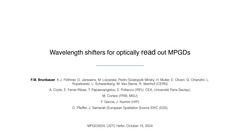Florian Maximilian Brunbauer
CERN
Antoine Cools
IRFU, CEA, Université Paris-Saclay
Marco Cortesi
Facility for Rare Isotope Beams, Michigan State University
Esther Ferrer-Ribas
IRFU, CEA, Université Paris-Saclay
Karl Jonathan Flöthner
CERN;University of Bonn
Francisco Garcia
Helsinki Institute of Physics
Djunes Janssens
CERN
Marta Lisowska
CERN
Hans Muller
CERN
Juha Nummi
Helsinki Institute of Physics
Eraldo Oliveri
CERN
Giorgio Orlandini
Friedrich-Alexander-Universität Erlangen-Nürnberg;CERN
Thomas Papaevangelou
IRFU, CEA, Université Paris-Saclay
Dorothea Pfeiffer
European Spallation Source ERIC (ESS)
Emmanuel Pollacco
IRFU, CEA, Université Paris-Saclay
Leszek Ropelewski
CERN
Jerome Samarati
European Spallation Source ERIC (ESS)
Lucian Scharenberg
CERN
Miranda Van Stenis
CERN
Ron Veenhof
CERN




Comment submit